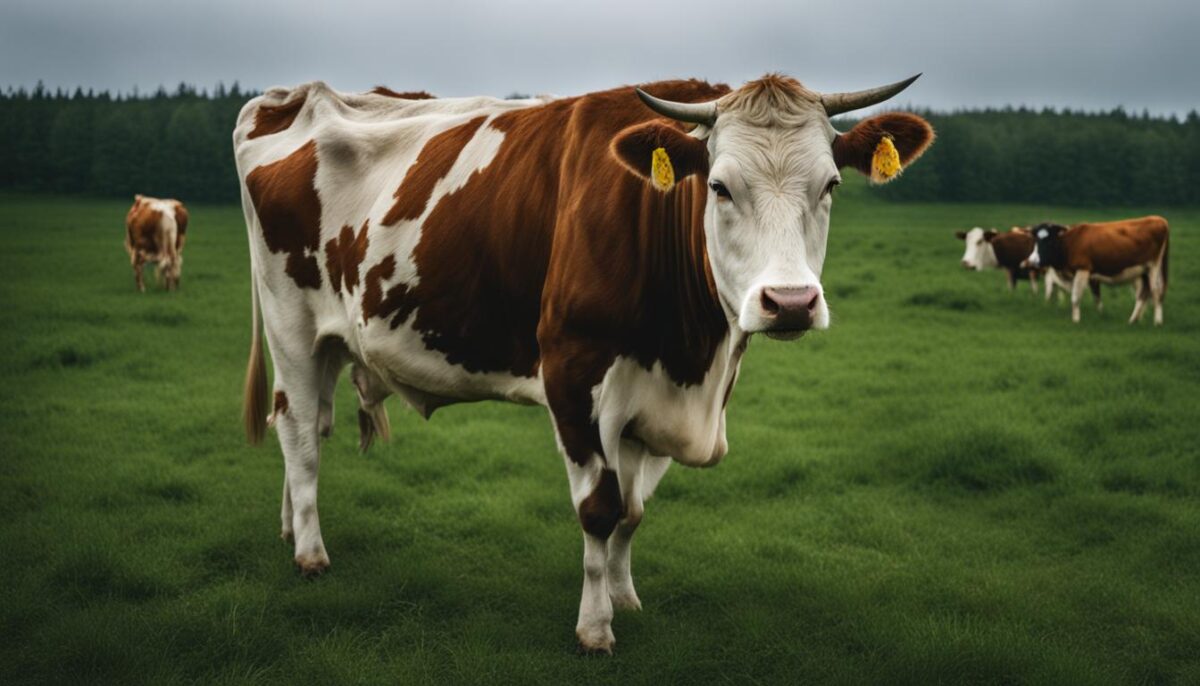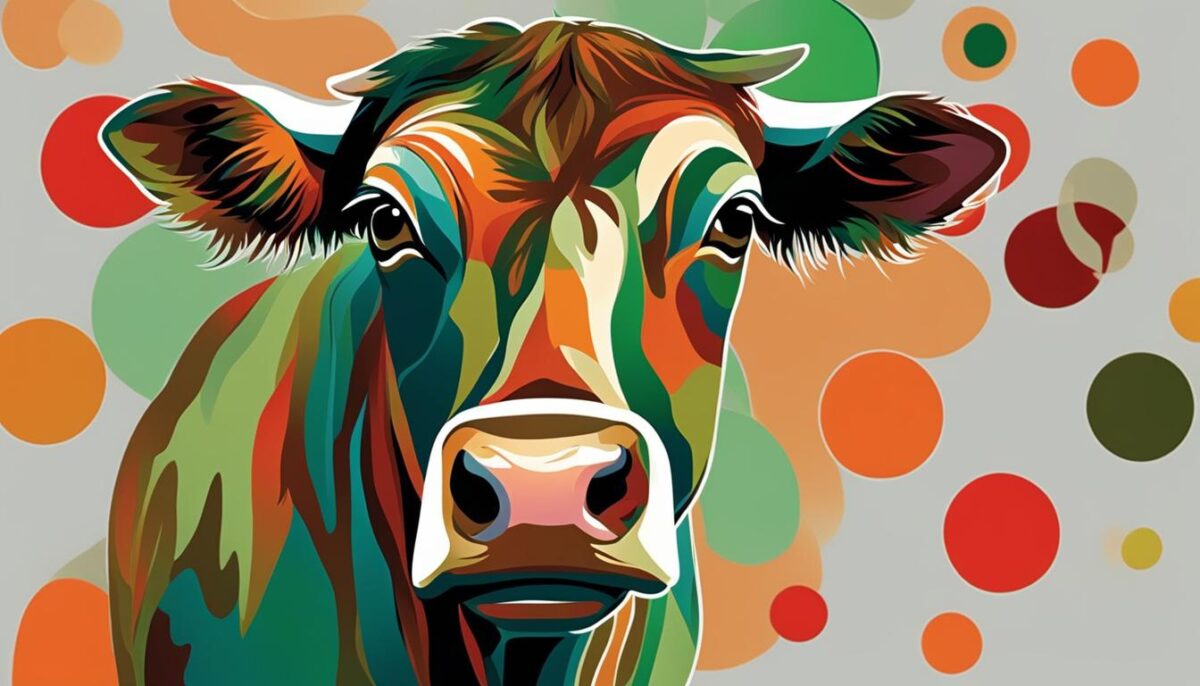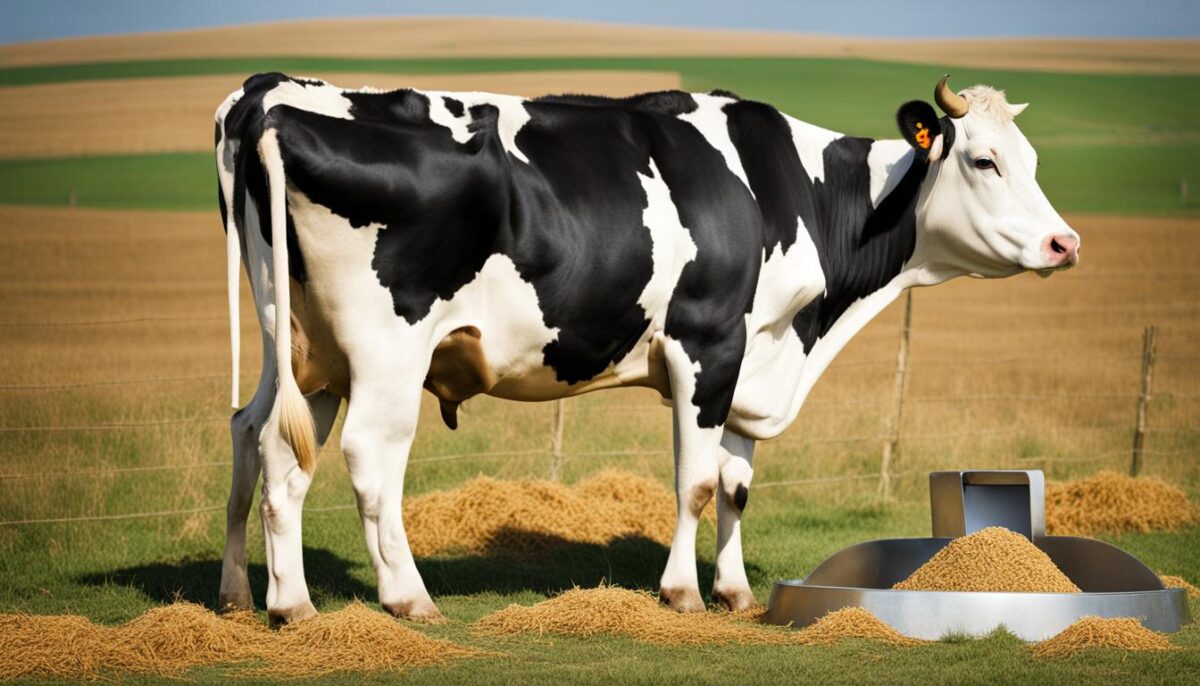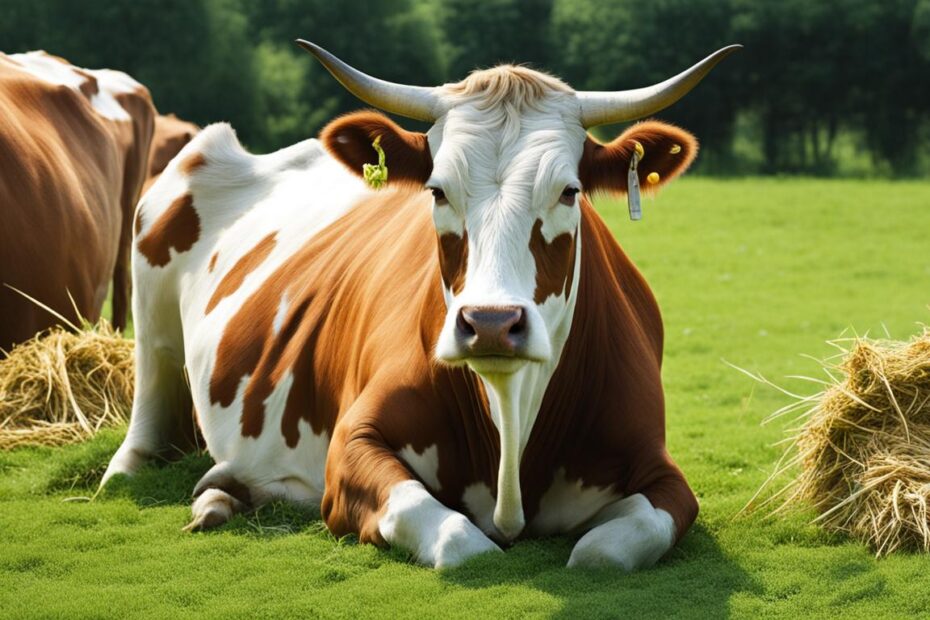Unexplained weight loss in cows can be a concerning issue for farmers. Despite consuming food, some cows may still experience a decrease in weight, leading to questions about their nutrition and overall health. Understanding the potential causes and implementing appropriate strategies is crucial for ensuring the well-being of these animals.
Key Takeaways:
- Cow eating but losing weight can be attributed to various factors such as diseases, nutritional deficiencies, and parasite infestations.
- Proper cow nutrition and feed management are essential for maintaining weight and preventing weight loss.
- Consulting with veterinarians and following best practices in cow feeding can help address potential issues and improve cow health.
- Regular monitoring of feed intake and pasture quality can support optimal weight management.
- Recognizing the signs of diseases such as John’s disease, leukemia, and bovine spongiform encephalopathy is crucial for early intervention.
Common Causes of Weight Loss in Cows
Weight loss in cows can be a concerning issue for farmers, as it can indicate underlying health problems or nutritional deficiencies. Understanding the common causes of weight loss in cows is essential for effective management and prevention. Here are some of the main factors that can contribute to weight loss in cows:
- Diseases: Certain diseases can cause significant weight loss in cows. Conditions such as John’s disease (paratuberculosis), leukemia, and bovine spongiform encephalopathy (BSE) can lead to decreased appetite, digestive issues, and overall poor health.
- Nutritional deficiencies: Insufficient intake of essential nutrients, including proteins and vitamins, can result in weight loss in cows. Imbalances in the diet or poor-quality feed can contribute to these deficiencies.
- Rumen acidosis: This metabolic disorder occurs when the pH of the cow’s rumen drops too low, leading to digestive disturbances, decreased feed intake, and weight loss.
- Gastrointestinal parasites: Infestations of parasites, such as Ostertagia ostertagi and Cooperia oncophora, can cause weight loss in cows. These parasites can affect the cow’s ability to absorb nutrients and can lead to reduced feed intake.
By recognizing these common causes of weight loss in cows, farmers can take appropriate measures to address them and prevent further weight loss. Regular monitoring of the cow’s health, implementing parasite control programs, providing a balanced and nutritious diet, and seeking veterinary assistance when necessary are crucial for maintaining optimal cow weight and overall well-being.
Table: Common Causes of Weight Loss in Cows
| Cause | Description |
|---|---|
| Diseases | Conditions such as John’s disease, leukemia, and BSE can cause weight loss in cows due to decreased appetite and digestive issues. |
| Nutritional deficiencies | Insufficient intake of proteins and vitamins in the diet can lead to weight loss in cows. |
| Rumen acidosis | A metabolic disorder that occurs when the pH of the rumen drops too low, resulting in digestive disturbances and decreased feed intake. |
| Gastrointestinal parasites | Infestations of parasites can affect nutrient absorption and lead to reduced feed intake, resulting in weight loss. |
Understanding John’s Disease in Cows
John’s disease, also known as paratuberculosis, is a serious disease that affects cows and can lead to significant weight loss. It is caused by the bacteria Mycobacterium paratuberculosis and primarily affects the intestines of infected animals. The bacteria cause chronic inflammation in the intestinal walls, which impairs the cow’s ability to absorb nutrients from its feed. This ultimately results in weight loss, reduced milk production, and diarrhea.
Diagnosing John’s disease in cows can be challenging due to its long incubation period and the difficulty in detecting the bacteria. The disease can take years to manifest symptoms, making it hard to identify infected animals early on. Furthermore, the bacteria are not easily detected through routine diagnostic tests, further complicating the diagnosis process.
Unfortunately, there is currently no cure for John’s disease in cows. Infected animals are often euthanized to prevent spreading the bacteria to other cattle. Implementing strict biosecurity measures, such as isolation and hygienic practices, is crucial in preventing the transmission of the disease within a herd. Regular testing and culling infected animals can help minimize the impact of John’s disease and reduce the risk of further contamination within the farm.
In conclusion, John’s disease is a significant concern for farmers due to its detrimental effects on cow health and weight. Understanding the causes, symptoms, and prevention measures associated with this disease is essential for maintaining the well-being of cattle and minimizing economic losses within the industry.
Leukemia in Cows and Its Effects on Weight
Cows can suffer from leukemia, a disease caused by the bovine leukemia virus (BLV). Leukemia in cows can have significant effects on their weight and overall health. Infected cows may experience weight loss, anemia, weakness, anorexia, and the formation of tumors in various organs.
The bovine leukemia virus is mainly transmitted through direct contact with infected blood, usually through contaminated needles or from an infected mother to her calf during birth or through milk. Once infected, cows remain carriers of the virus for life, spreading it to other cows through blood exchanges or contaminated milk.
Unfortunately, there is currently no cure for leukemia in cows. Infected cattle must be slaughtered to prevent the spread of the disease to other animals. It is important for farmers to implement effective management strategies, such as regular testing for BLV, separating infected cows from the herd, and practicing proper biosecurity measures to minimize the risk of transmission.
“Leukemia in cows is a serious condition that can have a major impact on the health and productivity of a herd. Identifying and managing infected animals is crucial to prevent the spread of the disease and protect the overall well-being of the herd.”

Table: Effects of Leukemia on Cow Health
| Effects of Leukemia | Description |
|---|---|
| Weight Loss | Cows infected with leukemia may experience gradual weight loss over time due to the impact of the disease on their overall health and appetite. |
| Anemia | Leukemia can lead to anemia in cows, resulting in weakness, lethargy, and decreased production. |
| Weakened Immune System | The presence of the bovine leukemia virus can compromise the cow’s immune system, increasing the risk of secondary infections and reducing their ability to fight off diseases. |
| Tumor Formation | In some cases, leukemia can lead to the development of tumors in various organs, further impacting the cow’s health and well-being. |
Managing leukemia in cows requires a proactive approach, including regular screening of the herd, minimizing exposure to infected animals, and implementing strict biosecurity measures. It is essential for farmers to work closely with veterinarians to develop a comprehensive disease management plan and ensure the long-term health and productivity of their cows.
Understanding Bovine Spongiform Encephalopathy (BSE)
Bovine spongiform encephalopathy, commonly known as mad cow disease, is a neurological disorder that affects cows. This disease is caused by abnormal proteins called prions that accumulate in the brain, leading to the degeneration of nerve cells. BSE is characterized by weight loss, weakness of the hind legs, tremors, excessive nose licking, and loss of body condition.
It is important to note that BSE is a zoonotic disease, meaning it can be transmitted to humans through the consumption of contaminated meat products. The human form of BSE is known as variant Creutzfeldt-Jakob disease (vCJD) and can have severe neurological effects.
The transmission of BSE primarily occurs through the consumption of feed contaminated with infected animal tissues. Strict regulations and guidelines have been implemented in the livestock industry to prevent the spread of BSE. These include bans on feeding animal by-products to cattle and implementing proper surveillance and testing protocols.
The Impact of BSE on the Livestock Industry
BSE has had significant economic and social impacts on the livestock industry. When outbreaks of BSE occur, it can result in the loss of consumer confidence and a decline in beef consumption. This, in turn, can lead to financial losses for farmers and ranchers.
Efforts to control and prevent BSE have been successful in many countries. Strategies such as strict feed regulations, surveillance programs, and safe slaughter practices have helped minimize the risk of BSE transmission. However, ongoing monitoring and vigilance are still necessary to ensure the continued safety of the food supply and the health of both animals and humans.
| Impact of BSE on the Livestock Industry | Details |
|---|---|
| Loss of consumer confidence | Consumers may be hesitant to purchase beef products due to concerns about BSE contamination. |
| Financial losses for farmers | Farmers and ranchers may experience reduced demand for their cattle, leading to financial hardships. |
| Increased regulations | The livestock industry has had to implement stricter regulations to prevent the spread of BSE. |
| Public health concerns | BSE has raised public health concerns, particularly regarding the transmission of the disease to humans. |
In conclusion, Bovine Spongiform Encephalopathy (BSE) is a serious neurological disease that affects cows and can have significant impacts on the livestock industry. Understanding the transmission and impact of BSE is essential for implementing effective control and prevention measures to protect both animal and human health.
The Impact of Rumen Acidosis on Cow Weight
Rumen acidosis is a metabolic disease that affects cattle and can have a significant impact on cow weight. It occurs when the pH of the rumen, the first compartment of the cow’s stomach, falls below 5.5. This acidic environment disrupts the normal fermentation process in the rumen, leading to digestive issues and overall poor health in cows.
Cows with rumen acidosis often experience a decrease in feed intake and poor body condition, which can result in weight loss. Diarrhea may also occur as a result of the disrupted digestive process. Additionally, cows suffering from rumen acidosis may exhibit behaviors such as reduced cud chewing, excessive salivation, and panting.
Preventing rumen acidosis requires careful management of the cow’s diet. High-grain diets, particularly those high in starch, can increase the risk of acidosis. To mitigate this risk, farmers should gradually introduce grains into the cow’s diet and ensure a balanced ration that meets the cow’s energy needs. Monitoring feed intake, providing adequate fiber, and avoiding sudden dietary changes can also help prevent rumen acidosis.

Table: Symptoms of Rumen Acidosis in Cows
| Symptoms | Explanation |
|---|---|
| Decreased feed intake | Cows with rumen acidosis may eat less due to digestive discomfort. |
| Poor body condition | Cows may lose weight and have a lack of muscle tone. |
| Diarrhea | Disrupted fermentation in the rumen can lead to loose stools. |
| Reduced cud chewing | Cows may chew their cud less frequently or for shorter periods of time. |
| Excessive salivation | Cows may drool excessively due to discomfort. |
| Panting | Heat stress resulting from acidosis can cause cows to pant. |
In conclusion, rumen acidosis can significantly impact cow weight due to decreased feed intake, poor body condition, and digestive issues. Proper diet management, including gradual grain introduction, balanced rations, and careful monitoring, is essential for preventing rumen acidosis and maintaining cow health.
The Role of Gastrointestinal Parasites in Cow Weight Loss
Gastrointestinal parasites can have a significant impact on the health and weight of cows. Common parasites in cows include Ostertagia ostertagi and Cooperia oncophora. These parasites can cause reduced weight gain, decreased feed intake, and overall poor performance in cows. It is essential for farmers to understand the effects of gastrointestinal parasites and implement proper control measures to prevent weight loss and maintain the health of their cattle.
Gastrointestinal parasites can disrupt the cow’s digestive system, leading to poor nutrient absorption and utilization. This can result in reduced weight gain and energy levels, ultimately affecting the overall condition of the animal. Parasite infestations can also contribute to other health issues, such as diarrhea and anemia, further exacerbating weight loss in cows.
To prevent and manage gastrointestinal parasites in cows, farmers should follow a strategic deworming program recommended by veterinarians. This program may involve regular fecal analysis to identify the presence of parasites and targeted deworming treatments based on the specific parasite species involved. Pasture management practices, such as rotational grazing and maintaining clean and dry environments, can also help minimize parasite exposure and reduce the risk of weight loss in cows.
Table: Comparison of Common Gastrointestinal Parasites in Cows
| Parasite | Effects | Control Measures |
|---|---|---|
| Ostertagia ostertagi | Reduced weight gain, decreased feed intake, anemia | Strategic deworming, pasture management |
| Cooperia oncophora | Poor weight gain, diarrhea | Strategic deworming, pasture management |

Best Practices for Cow Feeding
- Provide access to clean, fresh water at all times.
- Offer a consistent and well-balanced diet, considering the nutritional needs of each cow.
- Ensure adequate forage availability and quality, as forage is essential for proper rumen function and overall health.
- Introduce dietary changes gradually to minimize digestive disturbances.
- Consider utilizing professional nutritionists to develop customized feeding programs tailored to the specific needs of the herd.
Weight Loss Diet for Cows
If cows are experiencing weight loss, it may be necessary to implement a weight loss diet under the guidance of a veterinarian or nutritionist. A weight loss diet typically involves reducing energy intake while maintaining adequate nutrient levels. This can be achieved by adjusting the feed ration to include more fiber-rich forages and limiting concentrated feeds.
It is important to note that weight loss diets should be implemented gradually to avoid metabolic imbalances or other health issues. Monitoring cow weight regularly during the weight loss period is crucial to ensure the diet is effective and sustainable.
Conclusion
Unexplained weight loss in cows can be a cause for concern, as it may indicate underlying health issues or nutritional deficiencies. By understanding the common causes of weight loss in cows, such as diseases like John’s disease, leukemia, and bovine spongiform encephalopathy, as well as factors like rumen acidosis and gastrointestinal parasites, farmers can take proactive measures to address these issues and prevent further weight loss.
While some diseases, like John’s disease and leukemia, have no cure and may require infected animals to be put down, early detection and management can help minimize the impact on the herd. Additionally, implementing proper nutrition and feed management practices, including providing a balanced diet and monitoring feed intake, can support optimal weight management in cows.
It is essential for farmers to work closely with veterinarians and follow best practices in cow nutrition and health management to ensure the well-being of their cows. By addressing the potential causes of weight loss and implementing appropriate measures, farmers can safeguard their herd’s health, productivity, and overall welfare.
FAQ
What are the common causes of weight loss in cows?
Common causes of weight loss in cows include heavy parasite load, gastrointestinal parasites, dietary deficiencies, rumen acidosis, and certain diseases like John’s disease, leukemia, and bovine spongiform encephalopathy.
What is John’s disease and how does it affect cow weight?
John’s disease, also known as paratuberculosis, is caused by the bacteria Mycobacterium paratuberculosis. It leads to intestinal inflammation, resulting in low milk production, diarrhea, and significant weight loss in cows.
How does leukemia affect cow weight?
Leukemia is a disease caused by the bovine leukemia virus. It can lead to weight loss, anemia, weakness, anorexia, and the formation of tumors in various organs. Infected cattle must be slaughtered to prevent the spread of the disease.
What is Bovine Spongiform Encephalopathy (BSE) and how does it impact cow weight?
Bovine spongiform encephalopathy, also known as mad cow disease, is a neurological disease that affects cows. It can cause weight loss, weakness of the hind legs, tremors, excessive nose licking, and loss of body condition. BSE is fatal and can have significant impacts on the health and productivity of cows.
How does rumen acidosis impact cow weight?
Rumen acidosis is a metabolic disease that affects cattle, resulting in decreased feed intake, poor body condition, weight loss, diarrhea, and other symptoms. Acidosis occurs when the pH of the rumen falls below 5.5, leading to digestive issues and overall poor health in cows.
What role do gastrointestinal parasites play in cow weight loss?
Gastrointestinal parasites, such as Ostertagia ostertagi and Cooperia oncophora, are among the most problematic health concerns for cattle. These parasites can cause reduced weight gain, decreased feed intake, and overall poor performance in cows.
How can nutrition and feed management help maintain cow weight?
Proper nutrition and feed management play a crucial role in maintaining cow weight. Cows should be provided with a balanced diet that meets their energy and protein requirements. Regular monitoring of feed intake, along with managing pasture quality and grazing practices, can support optimal weight management in cows.
What should farmers do to address weight loss in cows?
It is essential for farmers to identify the underlying causes of weight loss in cows, such as diseases, nutritional deficiencies, or parasite infestations. By working closely with veterinarians and following best practices in nutrition and feed management, farmers can take appropriate measures to address and prevent weight loss in their cows.


